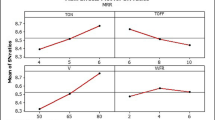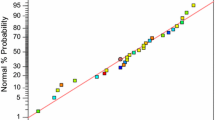Abstract
This article presents the relationship of machining parameters containing pulse-on time (Ton), pulse-off time (Toff), peak current (IP) and servo voltage (SV) on surface integrity characteristics, including white layer thickness (WLT), heat-affected zone (HAZ) and surface crack density (SCD) and also on material removal rate (MRR), after wire electric discharge machining of Ti–6Al–4V. Taguchi’s method was utilized to design the experiments, and response surface methodology (RSM) was employed for developing the empirical models. Results indicated that Ton and IP played a significant role on surface integrity characteristics. In addition, the microstructure of selected machined samples was analysed using a field emission scanning electron microscope (FESEM) and energy-dispersive X-ray (EDX) analysis. Accuracy of models was examined using residual analysis and confirmation runs. Finally, multi-response optimization of process parameters was obtained using desirability approach. Results can be used to improve the quality of the machined workpiece significantly to fulfil the requirements of the various industries. The novelty of this research is mainly investigation and multi-response optimization of all the surface integrity characteristics at the same time.










Similar content being viewed by others
Abbreviations
- T on :
-
Pulse-on time
- T off :
-
Pulse-off time
- IP:
-
Peak current
- SV:
-
Servo voltage
- WLT:
-
White layer thickness
- HAZ:
-
Heat-affected zone
- SCD:
-
Surface crack density
- MRR:
-
Material removal rate
- RSM:
-
Response surface methodology
- FESEM:
-
Field emission scanning electron microscope
- EDX:
-
Energy-dispersive X-ray
- WEDM:
-
Wire electrical discharge machining
- ANOVA:
-
Analysis of variance
References
Rao P V and Pawar P J 2009 Modelling and optimization of process parameters of wire electrical discharge machining. Proc. IMechE Part B: J. Eng. Manuf. 223: 1431–1440
Ho K H, Newman S T and Allen R D 2005 STEP-NC compliant information modelling for wire electrical discharge machining component. Proc. IMechE Part B: J. Eng. Manuf. 219: 777–784
Hsieh J F 2011 Modelling tool path in wire electric discharge machining using Denavit–Hartenberg notation. Proc. IMechE Part B: J. Eng. Manuf. 225: 1063–1072
Sarkar S, Ghosh K, Mitra S and Bhattacharyya B 2010 An integrated approach to optimization of WEDM combining single-pass and multipass cutting operation. Mater. Manuf. Process. 25(8): 799–807
Ghodsiyeh D, Golshan A and Shirvanehdeh J A 2013 Review on current research trends in wire electrical discharge machining (WEDM). Indian J. Sci. Technol. 6(2): 154–168
Boyer H E and Gall T L 1985 Metals handbook. Metals Park, Ohio: ASM Int., pp. 9.1–9.12
Donachie Jr. M J 2000 Titanium – a technical guide, 2nd ed. Ohio: ASM Int., pp. 318–323
Goswami A and Kumar J 2014 Investigation of surface integrity, material removal rate and wire wear ratio for WEDM of Nimonic 80A alloy using GRA and Taguchi method. Eng. Sci. Technol. Int. J. 17: 173–184
Newton T R, Melkote S N, Watkins T R, Trejo R M and Reister L 2009 Investigation of the effect of process parameters on the formation and characteristics of recast layer in wire-EDM of Inconel 718. Mater. Sci. Eng. A 513–514: 208–215
Kumar A, Kumar V and Kumar J 2013 Multi-response optimization of process parameters based on response surface methodology for pure titanium using WEDM process. Int. J. Adv. Manuf. Technol. 68(9–11): 2645–2668
Kumar A, Kumar V and Kumar J 2014 Surface integrity and material transfer investigation of pure titanium for rough cut surface after wire electro discharge machining. Proc. IMechE Part B: J. Eng. Manuf. 228(8): 880–901
Kumar A, Kumar V and Kumar J 2013 Investigation of machining parameters and surface integrity in wire electric discharge machining of pure titanium. Proc. IMechE Part B: J. Eng. Manuf. 227(7): 972–992
Puri A B and Bhattacharyya B 2005 Modeling and analysis of white layer depth in a wire-cut EDM process through response surface methodology. Int. J. Adv. Manuf. Technol. 25: 301–307
Kumar A, Kumar V and Kumar J 2016 Surface crack density and recast layer thickness analysis in WEDM process through response surface methodology. Mach. Sci. Technol. Int. J. 20(2): 201–230
Garg M P, Kumar A and Sahu C K 2017 Mathematical modeling and analysis of WEDM machining parameters of nickel-based super alloy using response surface methodology. Sadhana 42(6): 981–1005
Golshan A, Ghodsiyeh D and Izman S 2015 Multi-objective optimization of wire electrical discharge machining process using evolutionary computation method: effect of cutting variation. Proc. IMechE Part B: J. Eng. Manuf. 229(1): 75–85
Padhee S, Nayak N, Panda S K, Dhal P R and Mahapatra S S 2012 Multi-objective parametric optimization of powder mixed electro-discharge machining using response surface methodology and non-dominated sorting genetic algorithm. Sadhana 37(2): 223–240
Montgomery D C 2009 Design and analysis of experiments, 7th ed. Singapore: John Wiley & Sons, pp. 207–264
Lee H T and Tai T Y 2003 Relationship between EDM parameters and surface crack formation. J. Mater. Process. Technol. 142: 676–683
Noordin M Y, Venkatesh V C, Sharif S, Elting S and Abdulla A 2004 Application of response surface methodology in describing the performance of coated carbide tools when turning AISI 1045 steel. J. Mater. Process. Technol. 145: 46–58
Routara B, Bandyopadhyay A and Sahoo P 2009 Roughness modeling and optimization in CNC end milling using response surface method: effect of workpiece material variation. Int. J. Adv. Manuf. Technol. 40: 1166–1180
Sarkar S, Mitra S and Bhattacharyya B 2005 Parametric analysis and optimization of wire electrical discharge machining of γ-titanium aluminide alloy. J. Mater. Process. Technol. 159: 286–294
Kanlayasiri K and Boonmung S 2007 Effects of wire-EDM machining variables on surface roughness of newly developed DC 53 die steel: design of experiments and regression model. J. Mater. Process. Technol. 192–193: 459–464
Kanlayasiri K and Boonmung S 2007 An investigation on effects of wire-EDM machining parameters on surface roughness of newly developed DC53 die steel. J. Mater. Process. Technol. 187–188: 26–29
Lee S H and Li X P 2003 Study of the surface integrity of the machined workpiece in the EDM of tungsten carbide. J. Mater. Process. Technol. 139: 315–321
Hascalik A and Caydas U 2007 Electrical discharge machining of titanium alloy (Ti–6Al–4V). Appl. Surf. Sci. 253: 9007–9016
Ghodsiyeh D, Golshan A and Izman S 2014 Multi-objective process optimization of wire electrical discharge machining based on response surface methodology. J. Braz. Soc. Mech. Sci. 36(2): 301–313
Sadeghi M, Razavi H, Esmaeilzadeh A and Kolahan F 2011 Optimization of cutting conditions in WEDM process using regression modelling and Tabu-search algorithm. Proc. IMechE Part B: J. Eng. Manuf. 225: 1825–1834
Tosun N and Cogun C 2003 Analysis of wire erosion and workpiece surface roughness in wire electrical discharge machining. Proc. IMechE Part B: J. Eng. Manuf. 217: 633–642
Tzeng C J, Yang Y K, Hsieh M H and Jeng M C 2011 Optimization of wire electrical discharge machining of pure tungsten using neural network and response surface methodology. Proc. IMechE Part B: J. Eng. Manuf. 225: 841–852
Jia Y, Kim B S, Hu D J and Ni J 2010 Parametric study on near dry wire electro discharge machining of polycrystalline diamond-coated tungsten carbide material. Proc. IMechE Part B: J. Eng. Manuf. 224: 185–193
Hascalik A and Caydas U 2004 Experimental study of wire electrical discharge machining of AISI D5 tool steel. J. Mater. Process. Technol. 148: 362–367
Author information
Authors and Affiliations
Corresponding author
Rights and permissions
About this article
Cite this article
Ghodsiyeh, D., Akbarzadeh, S., Izman, S. et al. Experimental investigation of surface integrity after wire electro-discharge machining of Ti–6Al–4V. Sādhanā 44, 196 (2019). https://doi.org/10.1007/s12046-019-1184-z
Received:
Revised:
Accepted:
Published:
DOI: https://doi.org/10.1007/s12046-019-1184-z




